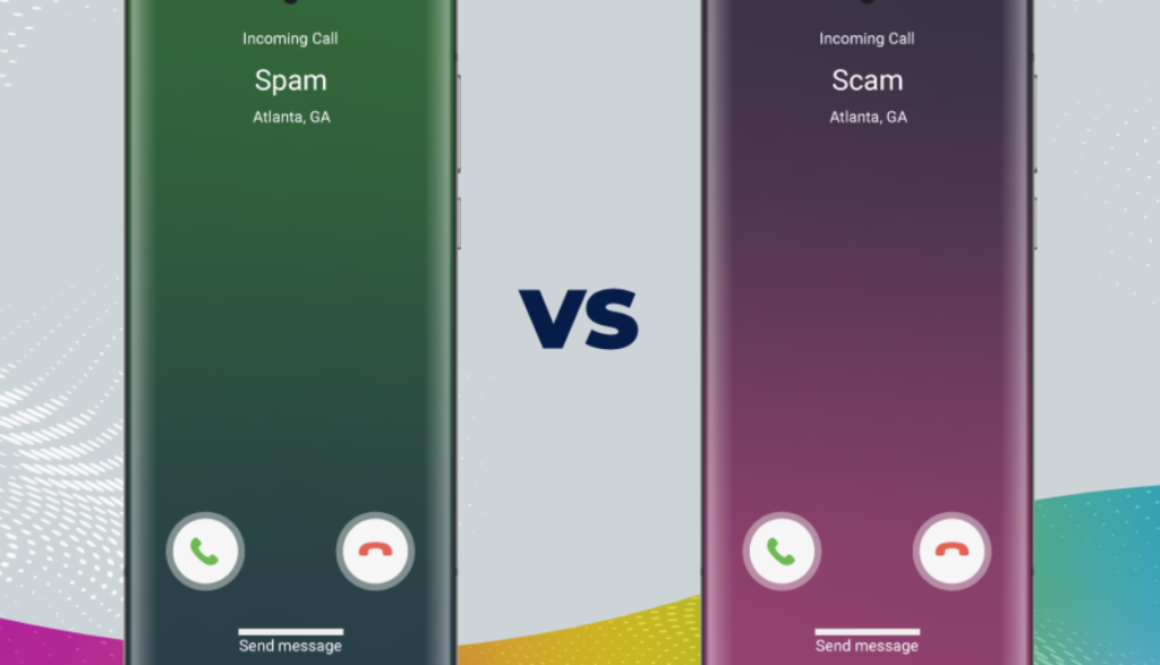Prevent Bad Tags On Your Outbound Calls: Scam vs. Spam

Have you ever felt the frustration of having one of your outbound calls tagged as a spam or scam call? Such labeling can result in the loss of valuable customer connections, wasted time, and revenue setbacks. If you’re reading this post, chances are you’ve faced this issue and are likely experiencing significant frustration.
But before you grab your pitchforks, it’s important to recognize that call tagging plays a crucial role in safeguarding callers. It actively prevents bad actors and irritating robocallers from exploiting customers’ trust.
You might also wonder how carriers differentiate between spam and scam calls and how to prevent these unwanted labels from being applied to your calls. To tackle this, let’s begin by clarifying the difference between a scam call and a spam call, as they are distinct concepts.
SCAM VS. SPAM
So, what distinguishes scam calls from spam calls?
Scam calls feature fraudulent activities, with the caller attempting to trick individuals into disclosing personal information, typically for financial gain.
In contrast, spam calls do not necessarily involve fraudulent schemes. Many spam calls originate from legitimate businesses that employ unfair or ineffective calling practices, causing annoyance to recipients. Examples of spammers include political or survey calls, as well as charitable organizations repeatedly seeking donations.
While both spam and scam calls share a deceptive nature, they differ in their intentions. Spam calls often come from legitimate businesses but can still be unwelcome to recipients. The labeling of these calls allows customers to decide whether to answer or ignore them.
HOW CALLS GET TAGGED
Every telecom provider utilizes distinct methods to assess incoming calls, determining whether they are likely wanted, potentially fraudulent (scams), or legitimate yet undesirable (spam).
Within the T-Mobile network, calls coming from unverified entities that might pose a fraudulent risk are labeled as “Scam Likely.” T-Mobile leverages advanced AI-driven analytics, powered by First Orion, to differentiate between genuine calls and scams.
This technology enables First Orion to distinguish calls maliciously spoofed by bad actors from legitimate ones. Even large organizations, such as national banks that make thousands of daily calls, can be vulnerable to spoofing attempts. However, our AI technology ensures accurate identification and tagging of spoofed calls as “Scam Likely,” leaving legitimate calls untouched.
It’s important to note that spam tagging methods employed by other carriers differ from those of First Orion and the T-Mobile network. Many alternative carriers lack similar technological capabilities, often relying on customer feedback to identify spam. Furthermore, they may struggle to differentiate between genuine calls and spoofed calls originating from businesses, potentially leading to more valid calls going unanswered.
If you’re eager to eliminate scam and spam call tags, read on for valuable best practices.
PREVENT TAGGING
Businesses often assume they have no control over being tagged as spam or scam callers. However, here’s some encouraging news – there are several best practices you can implement to reduce the likelihood of receiving an inaccurate label.
As a starting point, consider registering your business number with the Free Caller Registry. While this doesn’t offer an absolute guarantee against spam or scam tags, it assists carriers in categorizing your business correctly and recognizing it as legitimate.
Once your business number is registered, it’s essential to evaluate your calling strategy against the following checklist of best practices to ensure fairness and appropriateness for your customers:
- Avoid relying on a single central number for all calls.
- Minimize excessive calls to the same recipient.
- Ensure that your calls are expected by users.
- Respect users’ preferences regarding contact.
- Consistently provide an accurate and user-dialable telephone number with each call.
- Maintain a consistent Calling Name that aligns with the context.
- Ensure that the content and context of calls match the number’s intended purpose throughout its assignment.
- Document standard calling patterns.
- Refrain from using pre-recorded messages for lead prospecting calls.
- Avoid frequently calling unassigned numbers.
While removing a spam or scam tag isn’t a simple task, following these calling practices can enhance your business’s calling outcomes, reduce the likelihood of call blocking, and prevent future unwanted labeling as spam or scam.
Additionally, there’s another option you can explore to distinguish your calls to your customers.
BRANDED COMMUNICATION
With the INFORM® Branded Text Display, you can effectively showcase your business using a customizable 32-character display name.
INFORM is a valuable addition to your calling toolkit. However, it’s important to note that each carrier retains the final authority to label calls based on their individual spam and scam call prevention processes. The only foolproof method to prevent call spoofing is by utilizing INFORM Paired on the T-Mobile network.
INFORM also offers the following advantages:
- Protection of your brand from scammers.
- Custom branding that remains visible in the phone call log.
- Access to superior call data and top-notch analytics to enhance your outbound calling strategy.
INFORM reaches a broad audience, encompassing 2/3 of the U.S. mobile market, equating to over 280 million devices. This provides an added layer of assurance when reaching out to your clients through outbound calls.
Curious to witness INFORM in action? You can experience a free demo today on our website. Discover how INFORM can revolutionize your calls and bolster your defenses against spam and scam callers.


